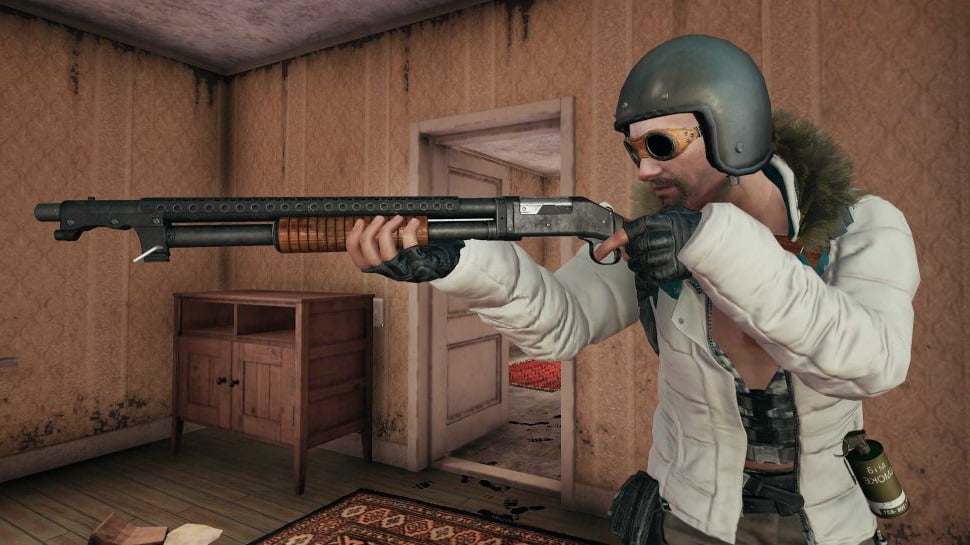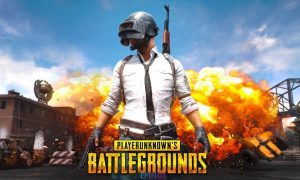A detailed Review about PlayerUnknown’s Battlegrounds PUBG

PUBG takes the tradition of big-map survival games like DayZ and compresses it into digestible, 3-to-30-minute sprints that are reliably scary and low-key.
What is it: A high-fidelity battle royale game made from Arma DNA.
Expect to pay: $30 / £27
Developer: PUBG Corporation
Publisher: PUBG Corporation
Reviewed on: Intel Core i7-4770K, 16GB RAM, GeForce GTX 980Ti
Multiplayer: 100 players (solo or in squads of 2-4) online
through matchmaking or custom games
PUBG is a bloodsport played beneath a pantheon of fickle gods. First, you fall out of heaven. When you hit the ground, you’re immediately praying that the Loot Lords put an SMG or double-barrelled shotgun in your hands. Survive this genesis and exodus, and you’ll redirect your prayers to the Goddess of Circles, whose force field decides who lives and dies. Later you’ll look up to The Crate God (Kratos), hoping for a long-barrelled gift from the sky. Other minor deities govern vehicle fuel levels, 8X scope propagation, and high-tier armor.
It’s a competitive game governed by semi-randomized systems that can feel capricious, but PUBG works in part because it throws conventional balance out the window. You’ve thrown yourself into a maelstrom of unfairness, an ever-shrinking RNG colosseum. You’re trying to be the last man standing among 100 competitors, and if you’re incredibly good, you’ll win 20 percent of the time. The normal way to die is suddenly, from an unknown direction.
As a shooter, it is the opposite of the kind of mathematical, chessboard balance seen in CS: GO or Rainbow Six Siege, where a comparatively finite number of variables narrows decision-making. The only time this happens in PUBG is when you reach the final circle or two, where the play area becomes small enough to fit in your brain.
And yet, something wonderful happens as a result of PUBG’s scale and randomness: you accept that you probably won’t win. Failure is the expectation. Death is basically inevitable, so hey: might as well make meaning out of the death you’re given. Technical issues, uneven art, and pesky cheaters erode that fun, but with the pressure to win somewhat lifted, PUBG becomes a playground for giving and receiving peril.
The art of not giving a damn
I’m happiest when I’m harassing a team that can’t locate me. There’s an art and science to it. You’ve got to pick a great spot: ideally, a narrow crook between some wreckage, with at least a 4X scope and a suppressor affixed to your gun. You have to pick the right moment to engage, and to do that, you have to read the body language of your enemy, at range. Where are they headed? Are they on alert, or at ease? If I’m lucky, I can catch them while they’re exchanging gear—a huge opportunity to put shots on someone while they have an empty AR in their hands.
I don’t care if I win or lose in these situations, which is weird, considering how explicitly cutthroat PUBG is. The population count in the top-right corner of the screen is a constant reminder of how close you are to be crossed off a list, and how much competition you have. Loot box currency is on the line, too—winning and eliminating players earns Battle Points, which can be spent on cosmetic item crates filled with mostly dull shirts and pants.
Despite PUBG’s booming skirt economy, loot boxes are probably the last thing on your mind. Most people I play with measure success by how much trouble they get into—whether your match generates a good Twitch clip, whether you were able to get revenge on the group that KO’d your friend, or whether you took the opportunity, in a kill-on-sight game, to backflip your motorcycle off a hill at the least appropriate moment. The mindset PUBG cultivates in its players—let’s call it ‘casually competitive’—maybe its biggest achievement.
That doesn’t undercut its status as a skillful shooter, with many merit badges to earn: cartography, looting, boating, tactical driving, parachuting, cross country, sieging, spotting, first aid, airdrop retrieval, boxing. The breadth of verbs and micro-skills makes PUBG a richer experience over time because it always feels like there’s another trick to learn about driving, vaulting, grenading, whatever. I also like that distributing duties among a three- or four-person squad is itself a skill: hand the scoped Kar-98 to your best shot, and the keys to the Dacia to your daredevil.
Shooting has surprising depth. Despite its spacious maps, winning a team duel at short range takes about the same mixture of snap reflexes, aggression, stealth, and peeking ability you’d need on de_dust2. Damage is modeled differently across the body, limbs, and head. Guns have touchy, individualized recoil and bullet travel time. Check Twitch on a weekday and you’ll see CS: GO ex-pro Shroud at the top of the channel list, preferring around cover and pulling off sick spray transfers.
Luckily for those of us without divine aim, it isn’t everything. What’s more gratifying about PUBG’s gunfights to me is the ad-libbing and creativity it takes to manage the complex situations it puts you in. Say someone’s ambushed you from a second-story window—they’ve tagged your friend, who’s now incapacitated behind a tree and bleeding out. Your body armor is shot up and about to break. Do you pop a smoke grenade and run to revive them, or fight from where you’re standing? Maybe your third teammate could put some suppression into the windows of the building while you rush in, but wait, you can’t be sure how many friends this attacker might have. And look, there’s a vehicle parked at the bottom of the building—should you pop its tires to prevent a getaway, or keep it intact for your squad?
Decisiveness is a skill, and PUBG is a platform for dumb schemes and accidental bravery. The best areas of PUBG’s two maps promote this stuff, like the school on Erangel, or Pecado and Hacienda Del Patrón on Miramar: sprawling compounds with hiding spots, escape holes, ambush perches, and other traps waiting to be sprung. Unfortunately, it’s indoors that some of the combat dynamics fall apart. Melee is clumsy and unreliable, relegated to desperation or taunting. Almost all surfaces are impenetrable, and some fences can’t be shot through. Footstep audio doesn’t have enough fidelity to make hearing a reliable sense in all situations, making it hard to be certain whether someone’s above or below you.
Another gripe is that the level of visual polish varies a lot between the weapons. When you feed ammo to an empty AKM, your left arm reaches across your body to smack the charging handle, a nice detail. But some insights, like that of the M416, are blocky and low-res. The shotguns are unpleasant, unreliable, and hard to read. Worst, PUBG’s scale means that my framerate still occasionally dips by 20 fps at an inopportune moment, although hardware performance has improved tremendously since its early months. Our PUBG performance analysis has more details on hardware requirements if you’re interested.
These problems melt away at long range, where I think PUBG is at its best. My favorite phase in a match is about 10 minutes before the endgame when anyone still alive is geared to the gills but the circle is big enough that engagements are happening through 4X and 8X scopes. Each shot across a long canyon or field is a parabolic prayer—the target might’ve shifted three feet by the time your shot travels 300 meters and burrows into the dust, kicking out a particle effect. Hitting someone on the run at this distance convinces you you’re the son of Neo and Robin Hood, gifted with precognition. It feels damn, damn good.
Out of the blue
PUBG’s simplest system is also it’s most important. Every couple minutes, a new, smaller safe zone is randomly declared, telescoping within the area of the previous one. If you’re blessed, successive safe zones will seem to mirror your position. Anyone caught outside takes damage over time, and has to migrate under pressure. This asphyxiating grip PUBG exerts on its map is the force that puts its mechanics in motion. It works wonderfully, forcing players out of their comfort zones, encouraging mistakes and bad decisions, limiting how much looting and shooting you can do, and making the value of your real estate uncertain. Without this sense of urgency, PUBG would be dull.
It’s also artificial to the point of dissonance. No attempt is made to explain the origin of the scary blue electric field, the setting, or why you’re fighting to the death. Absent of voice acting or even rudimentary narrative handholds (the vaguely post-apocalyptic setting doesn’t offer many clues either), PUBG can feel hollow of personality, especially with each custom character issuing the same thousand-yard stare regardless of their situation. There is some upside to this story vacuum: you fill the void with your tales of heroism and idiocy.
PUBG’s guarantee of intensity is one of its best features, but it’s also pleasantly lazy. When 100 players are consolidated into teams of four, paranoia shrinks and the mood relaxes considerably as you wander from compound to compound absorbing gear. If an early-game bloodbath thins the server population, you might spend 15 minutes of a match wandering with your friends, exchanging loot, seeing and hearing no one, shooting the shit about work or what else you’ve been playing.
There’s surprising space for socializing, and it makes PUBG a rare multiplayer game with good pacing. The airdrop is an initial burst of excitement before lower-key migration and looting sets in, punctuated by ambushes that lead up to a crescendo finale. I find it best in duos or trios, where the ratio between shit-shooting and shooting shit feels roughly equal. As a foursome, combat can feel overcomplicated, and the endgame more asymmetrical, where the final dozen players might be a squad of four facing off against eight orphaned survivors.
In all modes of play, PUBG allows you to set your own risk level, beginning with the opening jump. You learn the hotspots quickly: the military base, Georgopol, and School are magnets for confident, deadly players. Hitting an unmarked farm will give you lots of security, but boredom and bad loot too. It’s an elegant design: choosing your spawn point is a way of choosing what kind of match you want to have.
Widely known
Months into PUBG’s lifespan, it broke records for concurrent players on Steam, and it’s already one of the best-selling PC games of all time. Success threatened to be its biggest obstacle—few games commit to exiting Steam’s pre-release program in just nine months, and I can’t think of any others that have become worldwide phenomenons, run multiple major esports events, launched on console, and introduced microtransaction systems on their way to doing it.
For the most part, PUBG has navigated its unprecedented growth well, but there are a few serious stretch marks. Hacking is the biggest present concern, but depending on who you ask, PUBG is either experiencing a pandemic of cheaters or nothing unusual for a popular multiplayer game. A natural downside of PUBG’s 100-player capacity, though, is that it gives hackers more room to hide than your average FPS. On December 28, the anti-cheat service employed by PUBG, BattlEye, noted that 1.5 million accounts had been banned.
Anecdotally, I’ve struggled to spot clear examples of hacking. In 31 recent first-person squad and solo games, in 14 of which I survived into the final 10 players, I didn’t encounter any bad apples. I have witnessed a few clear incidents on live streams where players manage unnatural headshot accuracy or seem able to track location through terrain and walls. There’s a reporting tool and killcam system for managing these jerks, but flagging someone after losing an unfair gunfight isn’t exactly revenge, especially when there isn’t confirmation that your report led to action. PUBG Corp. recently announced its intention to ban 100,000 players in an upcoming wave. I’m unsure whether that’s comforting or concerning.
The specter of hacking isn’t the only problem—PUBG still has an assortment of bugs, although a few of these masquerade as features. Both maps have strange collision issues with vehicles. You might clip an invisible piece of terrain and go cartwheeling down a hill, grimacing as your vehicle barely lands on its feet. But driving over the same hill or bump in your next match, the collision gods might direct their arbitrary wrath at you, spontaneously trampolining your UAZ into the air and detonating it, killing your whole squad.
A few less spectacular issues eat away at the fun. When leaping off a ledge, in rare cases PUBG will register the fall twice, inflicting double damage. Parachuting is similarly awkward, as PUBG struggles to sync your position if you clip a roof or ledge, making finesse drops harder to pull off. In a few spots, gear disappears through the ground completely if dropped. And at extremely long ranges, you may be able to spot a player but be unable to shoot them, as a rock or ridge fails to render, operating as a buggy, transparent barrier.
The true trouble is network performance, which simply isn’t a match for PUBG’s heavy emphasis on precision. As diagnosed in detail by experts like Battle(non)sense, the average server tick rate (around 20 Hz) isn’t just slightly lower than we’d expect, it’s also inconsistent throughout play, which makes hit registration feel likewise uneven. You might occasionally absorb a shot after you made it safely behind cover, or see a blood particle effect trigger a full second after you tag someone. It’s worst when the net code and animations don’t shake hands—I’ve died several times to players who look like they’re facing 90 degrees away from me, which makes me think I have an extra second to aim, and then they suddenly dome me.
The poky net code isn’t a huge distraction for me, but because there isn’t a network overlay or the ability to check other players’ pings, it’s frustratingly hard to diagnose the problem on your own. At least servers are broken into seven regions, though I’d like to see PUBG go a step further and soft-lock players with a certain ping from joining servers outside their region.
On the hardware side, I’m pretty happy with the state of PUBG’s graphical performance. Although framerate dips are common for everyone, it doesn’t crater for me in the way that some sandbox games do, despite cities and vistas dotted with thousands of objects. On a GTX 980Ti at 1440p and ultra settings, I easily manage more than 70 fps. On a more modest rig, with graphics turned to their minimum global setting at 1080p, I can hit an average of 60 fps on a variety of cards, from a GTX 1050 and GTX 680 to AMD’s R9 380 or RX 560. PUBG’s graphics settings themselves are flexible, but not exceptionally so. Currently, there’s a 144 fps cap that I’d love to see removed, or at least replaced with locked framerate options. The addition of three colorblind modes is good, and first-person FOV caps at a comfortable 103.
Taking it as a whole, PUBG is an achievement in contradictory brutality and breathing room. It’s a hyper-competitive sandbox shooter where you can be killed from half a kilometer away without any warning. It also has an autorun button so you can take a generous bite of your sandwich or shout thanks to your most recent Twitch subscribers. PUBG has plenty of issues to address before it fully exits adolescence, but its mixture of nonchalance and military intensity is deep, respectful of your time, and a reliable war story generator.
What types of games do you offer for download?
We offer a wide variety of games catering to different preferences and platforms. You can find everything from action-packed shooters and immersive RPGs to casual puzzles and indie gems. Our library includes games for PCs, consoles, and mobile devices.
Are the downloads free, or do I have to pay?
We offer free games. Some titles are available for free download.
Is it safe to download games from your website?
Yes, absolutely. We prioritize the safety and security of our users. All games available for download on our website undergo thorough screening for malware and viruses. Additionally, we partner with trusted developers and publishers to ensure that our users have a safe gaming experience.
How do I download games from your website?
Downloading games from our website is simple. Just browse through our library, select the game you want, and click on the download button. Follow the on-screen instructions to complete the download process. Depending on the size of the game and your internet speed, it may take some time to download.
Are there any age restrictions for downloading games?
Yes, some games may have age restrictions due to their content. We adhere to age ratings provided by official rating boards such as the ESRB, PEGI, and others. Make sure to check the age rating of each game before downloading to ensure it's suitable for your age group.
Can I share downloaded games with friends or family?
Sharing downloaded games with others may violate copyright laws and licensing agreements. We encourage our users to respect intellectual property rights and refrain from unauthorized distribution of downloaded games. If your friends or family members are interested in a particular game, encourage them to download it legally from our website.














